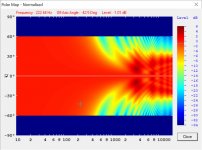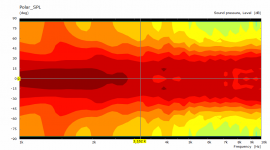I can't help but notice the similarities to my single flare conical. Mine is 29x12" mouth size and uss the 1" exit BMS4550 crossed at 1050Hz. It sounded great despite pretty terrible polars and waistbanding. Vertical pattern control was lacking.
I'm sure a secondary flare will make major improvement there but if you really want good polars, you should go the ATH direction. A 60 degree axisymmetric horn with optimized throat and mouth rollback would be just thing if you could figure out how to make one in a plus size 🙂
If you are adding mids you should definitely go to a 1" exit CD. I'm sure you will appreciate a CD whose top end is smooth prior to equalization. The BMS4550 does not sound harsh when crossed at 1050 with a 24 db electrical slope, which turned out to be 48 db acoustical.
I really like the 4NDF34; wish I had used them. I'll bet 4 of them are good for your SPL levels down to 200 Hz or so.
Hi Jack, reading your reply, i was guessing you had a 90 degree H with about a 2:1 aspect ratio, till i remembered to just click on your sig line. Lol.
I see the confirmation that tells me I've been spending way too much time with Synergy Calc haha. Yep, i bet the vertical polars and waist banding do look pretty wild. Amazing the great sound still, huh?
(i'm gonna go a little heretic here and say maybe vertical polars ain't all that for home use !!??)
I figure the large-size ATH stuff is definitely coming into being....very interesting the sims and prints being made. Just a matter of when the small-size builds lead the charge to economic larger builds...
I'd like to try the 1" BMS, but I'm kinda wed to 1.4". An adapter would be easy enough though i guess. The 1.4 Faital HF1440 is on the radar too.
Must say though, I'm very happy with both the BMS and B&C coaxes when used 650Hz up....no harshness then....so i dunno know about any more CDs yet.
I'm hoping the 4NDF34 are good to at least 250Hz. But I'll be fine with them if 300Hz is the end of their headroom.
A lot depends on how the 12" kappalite3012LFs do sealed. I want 1 1/2 octaves out of them; around 85Hz to 255Hz is the current hope. With the small mids doing 255Hz up to VD, where ever ends up sounding nicest.
I'll know tomorrow on the 12"s low end...fingers crossed...i REALLY don't want to add reflex ports.
I used Celestion TF0410MR drivers in PSE144. I belive they crossed in 1.150Hz. They provide very clear sound from 450Hz to the cross point. The reason of the two drivers instead of four was that the four drivers have barely noticeable sign of reverberation. To use two drivers I had to adjust a crossover and it was not an easy task. This happened 4 years ago and could be just my over suspicions and habits to improve things)))
Don't relay on that)))
Don't relay on that)))
Concentrated on the centre doesn't sound flat or spherical. I wish he had said more too but the questions were perhaps getting into difficult territory, amazing that Tom gives away as much as he does.As you no doubt noticed, TD said the ring radiators (like I'm using) tend to focus sound to the center of the exit...dunno what kind of wavefront that means? I do wish he had expounded more on your questions...
How do we make posts where we insert a series of comments in the middle of posts we are replying to... like you did in your reply to me #14.
You put them inside of Quote tags, I copy and paste the original line so it keeps the posters name
Attachments
I can't find the quote I was looking for but I know Tom Danley has said that the BMS4550 (ring radiator) produces a spherical wavefront, which mates well with a conical horn.
I did find this one "the BMS driver mentioned (which I use in some of our products at work), has a different internal structure which does not involve multiple paths which sum in a converging wave but has one summation path ending at the center at about 3/8 inch dia. From there forward inside the driver is a conical expansion which produces a diverging wavefront."
The driver he is referring to is the 4552 and the thread is here
Horn throat geometry: round to rectangular transition
I did find this one "the BMS driver mentioned (which I use in some of our products at work), has a different internal structure which does not involve multiple paths which sum in a converging wave but has one summation path ending at the center at about 3/8 inch dia. From there forward inside the driver is a conical expansion which produces a diverging wavefront."
The driver he is referring to is the 4552 and the thread is here
Horn throat geometry: round to rectangular transition
Concentrated on the centre doesn't sound flat or spherical. I wish he had said more too but the questions were perhaps getting into difficult territory, amazing that Tom gives away as much as he does.
Yes, his generosity is amazing. Especially as he is likely under some corporate pressure not to divulge.
You put them inside of Quote tags, I copy and paste the original line so it keeps the posters name
Thanks, copy/paste the original line was what i was missing...
I used Celestion TF0410MR drivers in PSE144. I belive they crossed in 1.150Hz. They provide very clear sound from 450Hz to the cross point. The reason of the two drivers instead of four was that the four drivers have barely noticeable sign of reverberation. To use two drivers I had to adjust a crossover and it was not an easy task. This happened 4 years ago and could be just my over suspicions and habits to improve things)))
Don't relay on that)))
Oh nice. That horn looks sweet. What do like most about its sound? Like least? What sub are you using to reach to 450Hz?
I can't find the quote I was looking for but I know Tom Danley has said that the BMS4550 (ring radiator) produces a spherical wavefront, which mates well with a conical horn.
I did find this one "the BMS driver mentioned (which I use in some of our products at work), has a different internal structure which does not involve multiple paths which sum in a converging wave but has one summation path ending at the center at about 3/8 inch dia. From there forward inside the driver is a conical expansion which produces a diverging wavefront."
The driver he is referring to is the 4552 and the thread is here
Horn throat geometry: round to rectangular transition
Thx for that. It's interesting to see the ferrite 4550 has a recommended xover at 800Hz, vs the neo 4552 at 1000Hz. Nice to lose 3lbs with the neo, but not worth an extra $100 and higher recommended xover to me.
Think i will try a 4550 after all... realized all i have to do is use a 3/8 BB mounting plate as an adapter, instead of the 1/8 alum i've been using for the 1.4".
Hi Mark,
First of all: Thanks for sharing all your experiences with these Synergy horns. I (and probably many others) really appreciate it! And congratulations on achieving a significant step forward in your search for audio Nirvana🙂.
Now, I may have missed something, but I am a bit confused about what actually caused this significant change you are hearing: (1) Is it the use of the smaller 4” mids playing in the 250-650 region, (2) raising the crossover point for the CD from 500 to 650 Hz, or (3) removing the 100-250 Hz mid-bass duty from the “old” mids, or??
I ask because I was actually attempting to make a 2-way Synergy myself to cover from about 130 Hz and up crossing in the 500-600 Hz region – at least that WAS the intention until I read this thread🙄.
Another way to ask is: If you only wanted your Synergy to reach down to 130 Hz in a home environment (not PA), would you then still prefer the 3-way approach?
Could you please elaborate on the reasons behind the sonic improvements you have experienced?
Thanks!
Best regards
Peter
First of all: Thanks for sharing all your experiences with these Synergy horns. I (and probably many others) really appreciate it! And congratulations on achieving a significant step forward in your search for audio Nirvana🙂.
Now, I may have missed something, but I am a bit confused about what actually caused this significant change you are hearing: (1) Is it the use of the smaller 4” mids playing in the 250-650 region, (2) raising the crossover point for the CD from 500 to 650 Hz, or (3) removing the 100-250 Hz mid-bass duty from the “old” mids, or??
I ask because I was actually attempting to make a 2-way Synergy myself to cover from about 130 Hz and up crossing in the 500-600 Hz region – at least that WAS the intention until I read this thread🙄.
Another way to ask is: If you only wanted your Synergy to reach down to 130 Hz in a home environment (not PA), would you then still prefer the 3-way approach?
Could you please elaborate on the reasons behind the sonic improvements you have experienced?
Thanks!
Best regards
Peter
Hi Peter,
All great questions.
I wish I fully knew whether the change was from (1) the small mids taking over from 25-650, or (2) the raised CD xover freq.
I think I can rule out (3) removing 100-250Hz from the "old" mids, because the same 10" drivers are still covering that range.
However, the 3" diameter single port used in center of the horn, was moved from about 5 1/2" from the throat out to 12 1/2" from the throat.
At 5 1/2" there was trouble reaching down to 120Hz, whereas 100Hz is now within reach.
At this stage, I'm thinking this is the achilles heel of a single sized driver reaching up to a CD......if its port(s) are place close to throat to raise its frequency up to the CD's, the cones bottom end gets hammered.
I've read TD say the port location establishes the frequency of an acoustic low-pass filter.
Or if port(s) are placed further out towards mouth for more bottom end, the cones high end response lowers, and the 1/4 wave reflected notch wreaks havoc.
Circling back to (1) or (2).....
I think it may be both.
In terms of solving the sometimes harsh edge, that got harsher with increasing SPL, my bet is raising the CD up to 650Hz gets the credit. The cones sound softer, yet still detailed.
In terms of the significant new found sound, the sometimes delightful near spooky sound, I'm thinking the 4 mids with their ports close in at 3.5" are the factor.
Or i should say i hope so ! I'm eagerly at work on the 60x60 with better cone drivers, praying it will at least equal the thrown together proto. Should know more within a couple of days...
Your last question..re a Synergy to reach only to 130Hz....
Not sure what you mean by a 3-way.....
I'll assume you mean a 3-way as CD + small mids + larger low cones.
Gosh, that's tough. I've been happy as heck with all my builds that used a single sized cone.
It would probably come down to knowing how well i like the CD down to the frequency it needs to reach.
If really happy there, then it comes down to is there any special "magic" to the soundfield from splitting up the drivers....which like said, i hope to know more about shortly.
Oh, one last observation, to help muddy the waters further ...(yikes)!
With the 10"s and the new port location, giving more authority/extension to the bottom, the bass sounds like it comes out of the horn more than it did before. I like it...would love to get 80-85Hz out of a Syn before crossing to sub...
All great questions.
I wish I fully knew whether the change was from (1) the small mids taking over from 25-650, or (2) the raised CD xover freq.
I think I can rule out (3) removing 100-250Hz from the "old" mids, because the same 10" drivers are still covering that range.
However, the 3" diameter single port used in center of the horn, was moved from about 5 1/2" from the throat out to 12 1/2" from the throat.
At 5 1/2" there was trouble reaching down to 120Hz, whereas 100Hz is now within reach.
At this stage, I'm thinking this is the achilles heel of a single sized driver reaching up to a CD......if its port(s) are place close to throat to raise its frequency up to the CD's, the cones bottom end gets hammered.
I've read TD say the port location establishes the frequency of an acoustic low-pass filter.
Or if port(s) are placed further out towards mouth for more bottom end, the cones high end response lowers, and the 1/4 wave reflected notch wreaks havoc.
Circling back to (1) or (2).....
I think it may be both.
In terms of solving the sometimes harsh edge, that got harsher with increasing SPL, my bet is raising the CD up to 650Hz gets the credit. The cones sound softer, yet still detailed.
In terms of the significant new found sound, the sometimes delightful near spooky sound, I'm thinking the 4 mids with their ports close in at 3.5" are the factor.
Or i should say i hope so ! I'm eagerly at work on the 60x60 with better cone drivers, praying it will at least equal the thrown together proto. Should know more within a couple of days...
Your last question..re a Synergy to reach only to 130Hz....
Not sure what you mean by a 3-way.....
I'll assume you mean a 3-way as CD + small mids + larger low cones.
Gosh, that's tough. I've been happy as heck with all my builds that used a single sized cone.
It would probably come down to knowing how well i like the CD down to the frequency it needs to reach.
If really happy there, then it comes down to is there any special "magic" to the soundfield from splitting up the drivers....which like said, i hope to know more about shortly.
Oh, one last observation, to help muddy the waters further ...(yikes)!
With the 10"s and the new port location, giving more authority/extension to the bottom, the bass sounds like it comes out of the horn more than it did before. I like it...would love to get 80-85Hz out of a Syn before crossing to sub...
Hi Mark,
Thanks a lot for your detailed reply! It makes sense for sure.
Sorry, I was not entirely clear in my question about a Synergy above about 130 Hz. I was hoping for a 'simple' Synergy based on Klipsch K402 with 2" Radian 950Be + Mids (e.g. 2 x Faital 8PR200) reaching down to about 130 Hz and then vented 18" subs below. I am willing to sacrifice some low end in the Synergies in exchange for first-class mid-high resolution.
I already have the K402s and the Radians, but I am a bit reluctant to cut in the K402s untill I am quite confident, it will work. And obviously, your recent first-hand experiences makes me think whether this is the right approach🙄
I look very much forward to hear about your further experiences with this new approach to the Synergies, so please do keep us posted🙂
Thanks!
Best regards
Peter
Thanks a lot for your detailed reply! It makes sense for sure.
Sorry, I was not entirely clear in my question about a Synergy above about 130 Hz. I was hoping for a 'simple' Synergy based on Klipsch K402 with 2" Radian 950Be + Mids (e.g. 2 x Faital 8PR200) reaching down to about 130 Hz and then vented 18" subs below. I am willing to sacrifice some low end in the Synergies in exchange for first-class mid-high resolution.
I already have the K402s and the Radians, but I am a bit reluctant to cut in the K402s untill I am quite confident, it will work. And obviously, your recent first-hand experiences makes me think whether this is the right approach🙄
I look very much forward to hear about your further experiences with this new approach to the Synergies, so please do keep us posted🙂
Thanks!
Best regards
Peter
Oh nice. That horn looks sweet. What do like most about its sound? Like least? What sub are you using to reach to 450Hz?
Well... All Synergy's have "huge headphones" kind of sound, very open and... I mean you can't detect where the mids ends and tweeter begin to work there. They are really one point sourse, like one huge wide range driver.
From 40 to 450hz I tried AE TD18H, later JBL2242 in 26-90Hz + B&C 15nw76 or JBL 2035HPL in kick horn. Also test them in the BR, but allways felt that for real synergy they suppost to be in the same horn in +-90-300hz range.
Now I wish I can cover 125-800Hz by the two 10" high resolution midbass drivers and 750-800Hz and up by 1.5" tweeter.
Last edited:
From 40 to 450hz I tried AE TD18H, later JBL2242 in 26-90Hz + B&C 15nw76 or JBL 2035HPL in kick horn. Also test them in the BR, but allways felt that for real synergy they suppost to be in the same horn in +-90-300hz range.
Now I wish I can cover 125-800Hz by the two 10" high resolution midbass drivers and 750-800Hz and up by 1.5" tweeter.
Yep, completely agree. Get as much of the spectrum into the synergy horn as possible.
I've done several builds that describe what you wish, two bigger cones (8's, 10's, and 12's) crossing straight to a CD.
Although 600-700Hz was about as high as I could get the big cones.
But that said, I've been hell bent on minimizing weight, and that goal kept me from box designs that allow the cones port placements closer to throat and hence a higher xover freq.
I still think this type design is the easiest, most pragmatic way to build a syn.
Maybe it gives up a bit of SQ compared to also using small mids, as i'm working on now to find out for sure. But even if it does, the simple 'single cone size to CD' syn design totally rocks as is.
Got some observations on the 60x60 current project, also using small mids along with low reaching CD. (and stronger low end drivers with their own ports location)
The small mids (four 4NDF34) work very well on this one, just like the 90x60 proto. Takes the sometimes harsh sound away from using the DCX464 down to 500Hz.
Tried taking the mid to CD xover to 900Hz, but simply lost clarity.
Now using tried and true 650Hz xover freq. Beautiful & natural detail. Vocals I've never heard before.
The little B&C mids really crank ! 200Hz would be fine. Currently crossing at 250Hz. (have four 16ohm in parallel.)
Win #1 🙂
The low drivers, kappalite 3102LFs, easily reach down to 100Hz sealed.
Down to 85Hz is no problem, and still playing with best sub xover freq.
All i know for sure is it will be 100Hz or less.
Win #2 🙂
The 60x60 conical with no secondary flare, kinda doubles up the oscillations in the 1-2kHz range that have been there on every build I've made. (Secondary flares have always cut it at least by half).
All the other builds had aspect ratios of 1.5:1, so only one set of walls (the side walls) appeared to make the disturbance. Now both sets appear to.
It also makes a tight no-mans land around dead on-axis H &V.
Forget measuring there haha. But get only 5 deg off and things get better quickly.
I've learned to make 10 degrees off axis the tuning reference on all the 1.5 aspect horns. I've learned to make 10 deg off both the H&V axis for this symmetrical 60x60.
The overriding reason to go to a 60x60 was to fit the taller kappalites in the lightweight type box i like. This made a larger sealed chamber than desired, but i thought that's OK, especially if i need to add reflex ports which will be helped by volume.
Since the drivers work fine sealed, I now wish the box height and sealed volume were smaller (back to like in 1.5 aspect), but it will take a different driver.
Also, the larger sealed space made rougher raw response traces than I've seen before...so much so, I swapped in some md12n351's to compare to the kappa's. Exact same response practically. I'm gonna call PE today and maybe work out a swap..
Loss #1 🙁
The sound...every bit as detailed and clear as the 90x60 proto...probably even a little more so. Certainly capable of greater clean SPL.
The 'magic factor'...is definitely there like the beater proto. The proto seemed (by memory)to have a little wider magic listening window than the 60x60. Will need to compare more here.
With either one, listening right around the 10 degree reference tuning axis is just plain wowsville !! (for me 🙂
Nice Tie #1 😉
Anyway, right now I'm quite sold on adding small mids..
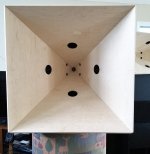
Oh, the dark circles that look like 12" ports are just pieces of cardboard added for visual symmetry effect. Without them, the ports in top and bottom created a strong optical illusion that made the box look extra weird, made it look taller than square when the mind knew it couldn't be. haha
The small mids (four 4NDF34) work very well on this one, just like the 90x60 proto. Takes the sometimes harsh sound away from using the DCX464 down to 500Hz.
Tried taking the mid to CD xover to 900Hz, but simply lost clarity.
Now using tried and true 650Hz xover freq. Beautiful & natural detail. Vocals I've never heard before.
The little B&C mids really crank ! 200Hz would be fine. Currently crossing at 250Hz. (have four 16ohm in parallel.)
Win #1 🙂
The low drivers, kappalite 3102LFs, easily reach down to 100Hz sealed.
Down to 85Hz is no problem, and still playing with best sub xover freq.
All i know for sure is it will be 100Hz or less.
Win #2 🙂
The 60x60 conical with no secondary flare, kinda doubles up the oscillations in the 1-2kHz range that have been there on every build I've made. (Secondary flares have always cut it at least by half).
All the other builds had aspect ratios of 1.5:1, so only one set of walls (the side walls) appeared to make the disturbance. Now both sets appear to.
It also makes a tight no-mans land around dead on-axis H &V.
Forget measuring there haha. But get only 5 deg off and things get better quickly.
I've learned to make 10 degrees off axis the tuning reference on all the 1.5 aspect horns. I've learned to make 10 deg off both the H&V axis for this symmetrical 60x60.
The overriding reason to go to a 60x60 was to fit the taller kappalites in the lightweight type box i like. This made a larger sealed chamber than desired, but i thought that's OK, especially if i need to add reflex ports which will be helped by volume.
Since the drivers work fine sealed, I now wish the box height and sealed volume were smaller (back to like in 1.5 aspect), but it will take a different driver.
Also, the larger sealed space made rougher raw response traces than I've seen before...so much so, I swapped in some md12n351's to compare to the kappa's. Exact same response practically. I'm gonna call PE today and maybe work out a swap..
Loss #1 🙁
The sound...every bit as detailed and clear as the 90x60 proto...probably even a little more so. Certainly capable of greater clean SPL.
The 'magic factor'...is definitely there like the beater proto. The proto seemed (by memory)to have a little wider magic listening window than the 60x60. Will need to compare more here.
With either one, listening right around the 10 degree reference tuning axis is just plain wowsville !! (for me 🙂
Nice Tie #1 😉
Anyway, right now I'm quite sold on adding small mids..

Oh, the dark circles that look like 12" ports are just pieces of cardboard added for visual symmetry effect. Without them, the ports in top and bottom created a strong optical illusion that made the box look extra weird, made it look taller than square when the mind knew it couldn't be. haha
HR can calculate directivity for a single segment conical but not if there is more than 1 segment. This polar map likely explains the variation with angles you've seen. In the sim which I did several years ago, the horn had a mouth area of 2753 cm2, ~20" on a side, and a depth of 45cm
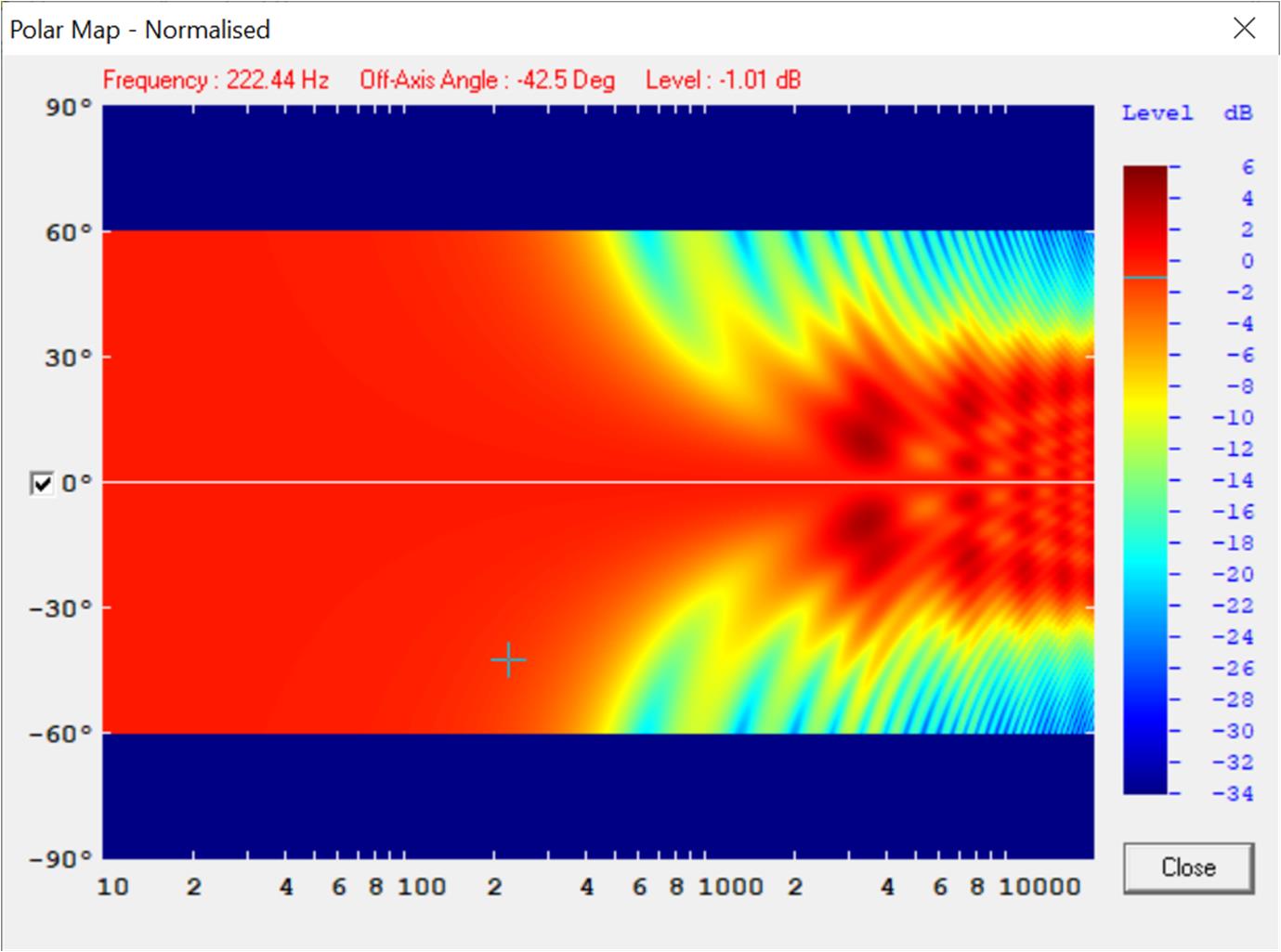
Attachments
Looks good!
For 650hz cross point how far is the midports from the horn throat?
Thx
The two boxes in this thread use a single 15/16" hole per driver, 3.5" center from throat.
Good to at least 1kHz, maybe 1.1kHz.
i think 4.5-5" should work pretty easily to 650Hz..
Oh btw, you know all the attention that's sometimes given to putting frustums and such on the ports...?
Here's what a master (not me! 🙂) did in that regard...i love it, my kind of easy!
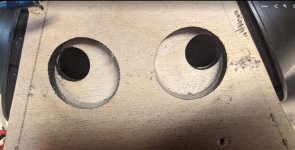
HR can calculate directivity for a single segment conical but not if there is more than 1 segment. This polar map likely explains the variation with angles you've seen. In the sim which I did several years ago, the horn had a mouth area of 2753 cm2, ~20" on a side, and a depth of 45cm
Yeppers, makes sense...
I'm guessing that sim was for something fortuitously close to a 60x60...?
For the 1k to 2kHz region, it's interesting how the sim shows 0 deg on-axis as pretty much OK. On-ax is where i find the shakiest response (within +/- 20 deg.
I think you might have missed the legend on the graph that says "Normalized" 😉For the 1k to 2kHz region, it's interesting how the sim shows 0 deg on-axis as pretty much OK. On-ax is where i find the shakiest response (within +/- 20 deg.
This is the non normalized polar from my 50x50 simulation with no secondary flare, 1 to 2K is messy for sure. This also in an infinite baffle so free air would be worse.
This is normalized to 10 degrees with the on axis response SPL response shown to the right. Attached below due to image size.
Interesting that you find the mids better over a limited bandwidth.
I'm also thinking that the audible difference between a horn with and without a secondary flare would point to how much value to place on improving the directivity smoothness.
Attachments
I think you might have missed the legend on the graph that says "Normalized" 😉
Not the first thing I've missed, huh? 😱😀
This is normalized to 10 degrees with the on axis response SPL response shown to the right. Attached below due to image size.
Thanks.
Here's measurements of tuning made to 10 deg horizontal and 10 deg vertical (red trace), vs on-axis.

Not the best measurements though...made indoors about 1.5m....all the things i advise not to do, haha.
Interesting that you find the mids better over a limited bandwidth.
I'm also thinking that the audible difference between a horn with and without a secondary flare would point to how much value to place on improving the directivity smoothness.
Yep. I don't know what to think yet. I'm not at all convinced the secondary flares with improved polars, are making a real audible difference. But then again, like we were talking, it's hard to isolate that variable.
The thing that gets me, is how adding the small mids has made for such an audible difference.
My other syn builds using a single sized cone to CD, and with secondary flares, have better polar sets... for sure.
But they don't sound quite as real... for sure, too.
Audio is fun...keeps me guessing Lol
- Home
- Loudspeakers
- Multi-Way
- SYN 9: a change in direction

